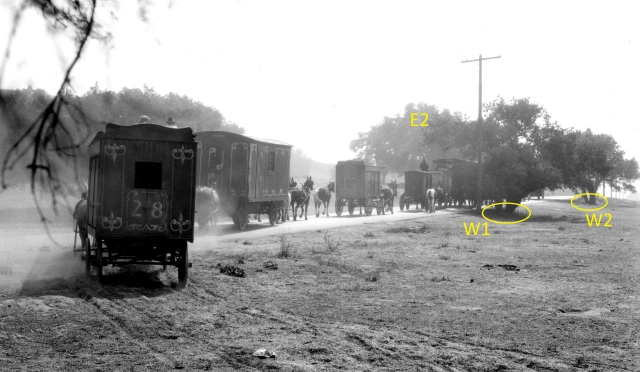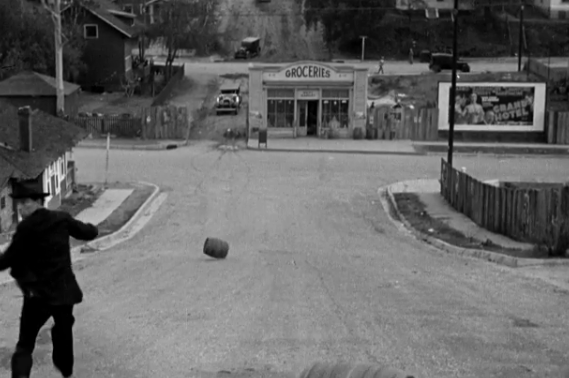 Paul Ayers, attorney, SoCal historian, and Altadena hiking trail expert and restorer, has shared many remarkable location discoveries over the years, including the finale from Charlie Chaplin’s The Circus (1928). Stemming from Paul’s discoveries, we now know a tree that witnessed Chaplin’s finale still survives (see below).
Paul Ayers, attorney, SoCal historian, and Altadena hiking trail expert and restorer, has shared many remarkable location discoveries over the years, including the finale from Charlie Chaplin’s The Circus (1928). Stemming from Paul’s discoveries, we now know a tree that witnessed Chaplin’s finale still survives (see below).
I met Paul after confessing in the first edition of Silent Echoes that I had no clue where Buster Keaton narrowly passed in front of an oncoming train in Sherlock Jr. (1924). Paul wrote to me with the correct solution, included in later editions of the book, and his methodology was stunning.
First, by noting the engine’s number, Paul excluded all Southern Pacific engines and rail lines. Next, given the design of the station at back, the lesser quality of the road bed, Paul’s sense that secondary rail lines are easier to shut down for filming, the lack of hills or desert terrain in the background, etc., Paul correctly surmised it was likely a secondary Santa Fe line in Orange County. Then, leafing through his train history books, Paul found photos from 1924 confirming the exact spot. Buster filmed riding up Richfield Road, crossing Orangethorpe Avenue in Atwood, in what is now Placentia. The rail line is still in active use today.
With similar skill and ingenuity, Paul has correctly identified numerous other locations, including one of my favorites, the final scene from The Circus, where the Little Tramp stands alone in a field watching his lady love and the rest of the circus crew leave him behind.

Click to enlarge – looking east towards Verdugo Road, above grade (notice the car within E6). Only the tree west of Verdugo, W2, casts a shadow below the road. The “E” trees stand east of Verdugo, E4-E6 along a side road “R” visible in the 1928 aerial below. Taller, and further east than E1 and E3, E2 appears in the photo below.
Knowing that the studio records mention Chaplin filmed the scene in Glendale, and that no major hills or mountains appear onscreen, Paul correctly surmised it must have been filmed looking south from the mouth of Verdugo Canyon. Triangulating from production stills and other clues in the movie, including auto traffic seen on what turned out to be Verdugo Road, Paul visited the site in person, and by matching ridge lines (a difficult task given all the homes there now), confirmed generally the circus field area as within Glenoaks Blvd., N. Adams Street, and Verdugo Road, north of the Wilson Middle School. I cover this, and Paul’s handiwork, more fully in my Chaplin book Silent Traces.

The circus wagon train departs south down Verdugo Road. Only two trees, W1 and W2 stood west of the road, and only W1 stood next to a telephone pole (see W2 in above photo). The surviving tree E2, the tallest, stands across the road.
 When I recently came upon vintage aerial photos of the Glendale shooting site, I realized there might be trees that witnessed the Chaplin production still standing today. (As I write in another post, certain trees at the Forest Lawn Hollywood Hills Memorial Park appear during the battle field scenes from The Birth of A Nation (1916), and in the 1937 Three Stooges short Playing The Ponies ).
When I recently came upon vintage aerial photos of the Glendale shooting site, I realized there might be trees that witnessed the Chaplin production still standing today. (As I write in another post, certain trees at the Forest Lawn Hollywood Hills Memorial Park appear during the battle field scenes from The Birth of A Nation (1916), and in the 1937 Three Stooges short Playing The Ponies ).
Above, both looking east, with Verdugo Road running north-south (left-right) across the images, these 1928 aerial views show the unique W1-W2 pair of trees west of Verdugo across from a cluster of six trees east of the road (E1-E6), and the side road (R) running beside E4-E6. Reckoning from the W1-W2 trees I was able to identify the corresponding trees in the two production stills annotated above. UC Santa Barbara c-300_k-181.
By 1938 (upper left), Verdugo Road had been widened and paved, losing the west W1-W2 trees in the process, as well as E1 and E3, the easterly trees closest to the road. By 1944 (upper right), homes were built west of Verdugo.
By 1952 the area east of Verdugo was also built over, with sidewalks installed along the east side of the street, leaving only one tree, E2, still standing. Visiting the site on Google Street View, it’s apparent why E2 remains. When they graded along the road to install the eastern sidewalk, they created a large square retaining wall to preserve the tree.
 Thus, just as there are trees that remain today having witnessed the making of The Birth of A Nation, a giant old oak tree in Glendale, appearing onscreen at left, witnessed the concluding scenes from The Circus.
Thus, just as there are trees that remain today having witnessed the making of The Birth of A Nation, a giant old oak tree in Glendale, appearing onscreen at left, witnessed the concluding scenes from The Circus.
Note: Paul was also the key to locating the avalanche of beer barrels scene in the Buster Keaton MGM talkie What No Beer? (1933). (Gif file courtesy of Danny Reid’s fascinating early cinema site Pre-code.com – What No Beer? review).

All images from Chaplin films made from 1918 onwards, copyright © Roy Export Company Establishment. CHARLES CHAPLIN, CHAPLIN, and the LITTLE TRAMP, photographs from and the names of Mr. Chaplin’s films are trademarks and/or service marks of Bubbles Incorporated SA and/or Roy Export Company Establishment. Used with permission.
Aerial photos UC Santa Barbara FrameFinder. Atwood train photo – Rails Through the Orange Groves: (Vol. II) by Stephen E. Donaldson and William A. Myers, Ronald D. Sands and Edward W. Cochens. What No Beer? © 1933 Turner Entertainment Co. Color images (C) 2017 Google.
The surviving tree at 920 N. Verdugo Road in Glendale.













spectacular detective work — by both you and your friend — Thanks for this fascinating stuff
LikeLike
Brilliant work in all cases. Intuition from one end to narrow the search to something less than infinite, dogged logic from the other end to find hard evidence that confirms the precise locations. And out of that, the past and present get tangibly connected. These are both great finds and also great examples of how what seem like impossible mysteries of film locations get solved. Thanks guys!
LikeLike
Thank you Robert for your eloquent words – I greatly appreciate it
LikeLike
Pingback: Three Good Fellows – Harold Lloyd, Doug MacLean, and Ben Model | Chaplin-Keaton-Lloyd film locations (and more)
Pingback: The Ghosts of Trolleys Past – Harold Lloyd’s Haunted Spooks | Chaplin-Keaton-Lloyd film locations (and more)